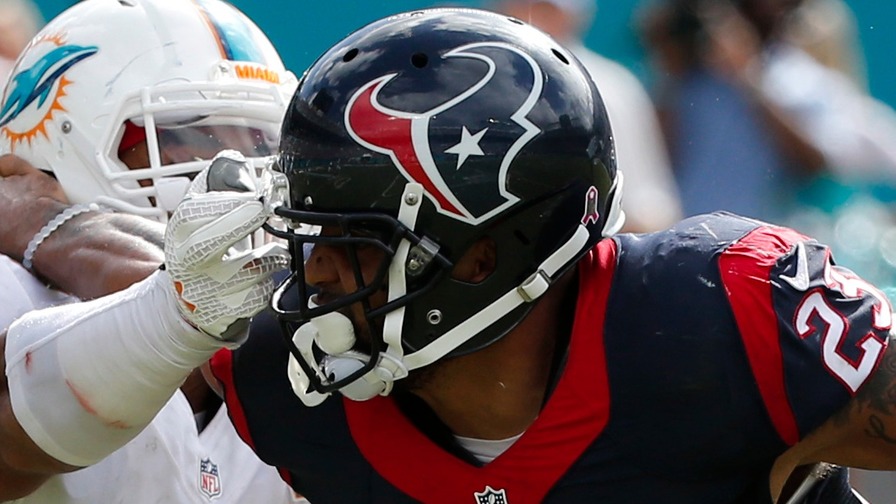Arian Foster Can Still Help the Miami Dolphins Backfield

The Miami Dolphins' running back issues continue.
And that's not even to say that they can't find a good one lately. The team just parted ways with Lamar Miller, whose advanced metrics suggest he is a legitimate NFL back, to make way for (ostensibly) Jay Ajayi, whose knee injuries from college knocked him down to the fifth round of the 2015 NFL Draft and made him a potential steal.
The Dolphins also spent a third-rounder in 2016 on Kenyan Drake out of Alabama. But to bolster the depth chart further, they brought in veteran rusher Arian Foster from the Houston Texans, essentially swapping spots with Miller.
Does the move make sense?
Foster's Metrics
Foster's career has been a good one. There's really no doubt about that. Among the 124 running backs who have seen at least 500 carries since 2000, Foster's points above expectation-level on his carries -- or Rushing Net Expected Points (NEP) -- of 18.25 ranks 23rd. You can read more about NEP in our glossary.
He's 28th on a per-carry basis (0.01) over his 1,454 attempts in that span. For some quick context, rushing is pretty inefficient, and running backs often accrue a negative Rushing NEP; last year's league-average Rushing NEP per play at the position was -0.04. Foster's career rate easily beats that.
Foster thinks that Miami head coach Adam Gase is going to be able to use his pass-catching skills -- which Foster believes to be his best ability -- properly. That part makes some sense.
Foster has also generated 133.25 points above expectation on his catches, which ranks 21st among 82 backs with at least 200 targets in this span (Foster had 345). On a per-target basis, his Reception NEP (0.39) ranks 14th, and his Reception NEP per Reception (0.54) ranks 13th.
In 2014, Foster posted a Reception NEP of 27.28, which ranked sixth among running backs, on 38 catches and 59 targets. Among 46 backs with at least 30 targets, his per-catch rate of 0.72 ranked fifth, and his per-target rate (0.46) ranked sixth.
Foster caught 22 of 28 targets in 2015, earning the fourth-best per-catch rate (0.81) and third-best per-target rate (0.64) of all backs with at least 28 targets.
His ability as a receiver is still apparent -- even while injuries hit him hard.
Rushing Decline?
Here's where things get cloudy. We already know that Foster has been great in his career, but his rushing metrics have dipped at times in the past few seasons.
Remember how the league-average Rushing NEP per carry for backs in 2015 was -0.04? Well, Foster's, albeit on just 63 carries, was -0.24.
The kicker is that the other Texans' running backs earned a cumulative score of -0.06, so they weren't exactly elite (or even league-average). But the difference between Foster's per-carry Rushing NEP and the rest of his team (-0.19) was the third-biggest gap between a 50-plus-carry rusher and his teammates in 2015. Only Tre Mason (-0.31) and Andre Williams (-0.25) were worse.
Foster has kind of been all over the place when it comes to comparison to his teammates recently.
| Arian Foster | Carries | Rush NEP/P | Teammates' Rush NEP/P | Difference |
|---|---|---|---|---|
| 2012 | 351 | -0.02 | 0.10 | -0.12 |
| 2013 | 121 | 0.00 | -0.06 | 0.06 |
| 2014 | 260 | 0.03 | -0.12 | 0.15 |
| 2015 | 63 | -0.24 | -0.06 | -0.19 |
Foster has been a mix of above-league-average and above the level of his teammates, but he has also been significantly behind his teammates, and his most recent line of work is problematic. Again, this came on a limited sample, but Foster isn't exactly the epitome of health right now, and that's something that can't be overlooked.
His Success Rates (the percentage of carries that lead to positive NEP) have been trending downward since 2013: 43.80%, 39.23%, and 38.10%.
However, his marks there outpace his teammates' rates, so perhaps he can still outshine his teammates even at this stage in his career. It's really hard to peg Foster's current rushing ability given his yo-yoing efficiency scores.
Takeaways
Foster still has the ability to be a productive receiver out of the backfield, and his rushing analytics -- though up-and-down and most recently way down -- suggest that he can still produce that way, too, if things go right.
His health could limit him, but he feels fully recovered after his Week 7 Achilles tear last year, and given Foster's contemplation of retirement in the past, it's probably safe to assume that he really does feel good enough to keep playing, making this a solid pickup for Miami at the least and a great one if Foster can really produce like the Foster of old.
Or maybe -- just maybe -- he wanted to keep Miami's backfield a nightmare to predict because he hates fantasy football. He's probably still good enough to earn a significant role and to do just that.
















